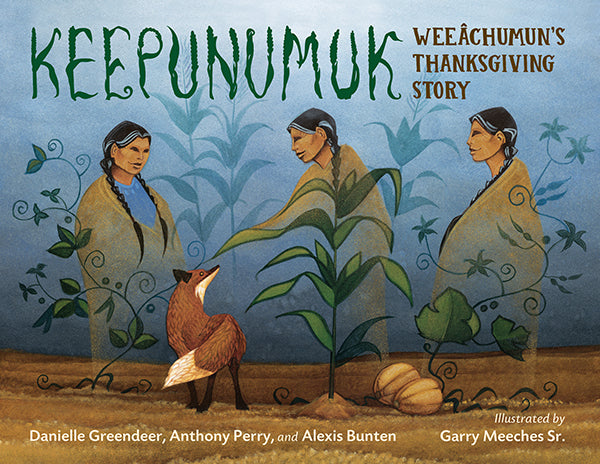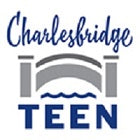Keepunumuk


Danielle Greendeer, author
Danielle Greendeer is a citizen of the Mashpee Wampanoag Nation and works in the areas of tribal governance, cultural perpetuation, and food sovereignty. She lives in Mashpee, Massachusetts.
Read more about Danielle.
Anthony Perry, author
Anthony Perry is a Chickasaw citizen and author of Chula the Fox, an award winning middle-grade historical-fiction book. He lives in London.
Read more about Anthony.
Alexis Bunten, author
Alexis Bunten, Yu'pik and Unangan, authored the award-winning nonfiction book, So How Long Have You Been Native? Life as an Alaska Native Tour Guide. She lives in Monterey, California.
Read more about Alexis.
Garry Meeches Sr., illustrator
Garry Meeches Sr. (Anishinaabe) was born on the Long Plains reserve in southern Manitoba, Canada. His style is reminiscent of the plains style of art and evokes the Eastern Woodlands tradition. He lives in Connecticut, and this is his first picture book.
Read more about Gary.
- A 2022 New England Book Award winner
- A Kirkus Reviews Best Book of 2022
- A Center for the Study of Multicultural Children's Literature Best Multicultural Children's Book of 2022
- A Children's Book Council Notable Social Studies Book of 2023
Kirkus Reviews, starred review
The Thanksgiving story, told from the perspective of the Wampanoag people.
A Wamponoag grandmother plants her garden with weeâchumun (corn), beans, and squash, or the Three Sisters. When her grandchildren ask to hear the story of Thanksgiving, N8hkumuhs tells them that their people call it Keepunumuk, “the time of harvest,” and explains what really happened. The tale opens with Seagull warning Weeâchumun—depicted as a woman with a translucent body—of the Pilgrims’ arrival; Weeâchumun worries because many of the First Peoples who cared for her have gone to the Spirit World, and she fears this will be her last winter. Fox keeps an eye out and in spring tells Weeâchumun and her sisters that the newcomers endured a hard winter; many died. Weeâchumun and her sisters want to help: “We will send the First Peoples to help the newcomers.” The Wampanoag people teach the survivors how to plant corn, beans, and squash. The settlers hold a feast to celebrate the harvest; though it’s remembered by many as the first Thanksgiving, backmatter explains that because of the disease and warfare brought by the settlers, for the Wampanoag people, it is remembered as a day of mourning. Rich, saturated acrylics imbued with a touch of magic add to the vibrancy of this important, beautiful story.
A much-needed Thanksgiving retelling that centers the Wamponoag people. (glossary, information on the Wampanoag map, recipes) (Picture book. 3-7)
Booklist, starred review
U.S. Thanksgiving is a day of mourning for North American First Peoples, given that European settlers brought disease and warfare to their land. Greendeer (Mashpee Wampanoag) and her Indigenous cocreators here recount a story of the first harvest feast in 1621 from an Indigenous perspective. When her grandchildren request a story, N8hkumuhs tells of Keepunumuk, the time of harvest. When new people arrive, Weeâchumun wonders if they can be trusted. They build houses on top of an empty village, steal corn seeds for planting, and misunderstand the ways of nature. In the spring, the People (particularly Tisquantum) help the newcomers to grow corn, bean, and squash, and in the fall, both groups celebrate together. Simply told, the story includes many Wôpanâak words and concepts. Three different typefaces distinguish the front and back matter from the modern framework and the older story-within-a story, an aid to younger readers. Meeches’ (Anishinaabe) acrylic illustrations are rendered in an Eastern Woodlands style. Greens and blues complement the earth-toned palette employed on most spreads; particularly effective is the depiction of the Three Sisters, spirits representing corn, beans, and squash. This is a perfect choice for anyone looking for an alternative perspective to the traditional Thanksgiving story or an Indigenous Peoples’ Day read.
School Library Journal
This picture book features a contemporary Wampanoag grandmother and her grandchildren. N8hkumuhs shares the story of the Three Sisters—Corn, Beans, and Squash—and the first Thanksgiving,known as “Keepunumuk” by the Wampanoag people. The book transitions into a combination of history and storytelling about contact between the “First Peoples” and the newcomers. This format will be novel to some young children given the setting and timeframe of the story, though the book attempts to differentiate the parts that are the story by changing the typeface and including ethereal-like images of the Three Sisters. “Before You Begin” and “Important Words to Know” sections also provide context. Rich back matter includes more information about the Wampanoag tribes, a traditional recipe, and a photo and information about the real Maple and Quill, the grandchildren in the story. Overall, this story is a good addition for the historical knowledge of the first Thanksgiving from the Wampanoag viewpoint.
VERDICT A good choice for libraries striving to share Indigenous perspectives.
Publishers Weekly
Opening sidebars contextualizing the Wampanoag tribes’ cultivation of their ancestral homeland and a glossary of Wôpanâak words is an edifying setup for this First Peoples narrative around Thanksgiving. While harvesting food from her garden, N8hkumuhs tells her grandchildren the tale of how the corn spirit Weeâchumun and her sisters, despite hesitance from watchful Fox, encouraged the First Peoples to teach European newcomers how to plant, fish, and hunt. In celebration, the newcomers prepared a feast and, together with the First Peoples, rejoiced for three days, leading to what most Americans call the First Thanksgiving, and “many of our people,” call a “day of mourning.” The creators’ poetic prose sensitively conveys the First Peoples’ lived history and foreshadows historical hardships to come. Meeches’s delicate brushstrokes, paired with bold swathes of earthen toned acrylic, add vibrancy. Additional information, including a traditional recipe, concludes. Ages 3–7.
The Horn Book
“Many Americans call it a day of thanksgiving. Many of our people call it a day of mourning.” A team of Native creators provides a refreshing look at what the Wampanoag called Keepunumuk, or “the time of harvest,” highlighting that the Pilgrims’ survival was largely due to the assistance offered by the Indigenous people who lived on the land. In the framing narrative, an elder speaks to children about their ancestors, and how weeâchumun, the seed of corn and one of the Three Sisters (corn, beans, and squash), witnessed the struggles of the newcomers. Using an earth-tone palette, the impressionistic illustrations beautifully convey their settings. Front and back matter include a glossary, a recipe, and more information about Wampanoag traditions, storytelling, and contemporary life.
Children's Literature
Keepunumuk: Weeâchumun’s Thanksgiving Story Danielle Greender, Anthony Perry, and Alexis Bunten Although storytelling is at the heart of the Wampanoag tradition, their perspective of the first Thanksgiving is all too frequently left out of American classrooms. Fortunately, this picture book brings the Native American or First Peoples’ side of the story to life. The book begins with a note for context, alongside a short glossary with pronunciations of the authentic Wampanoag words used throughout. The story itself is framed with a modern-day grandmother telling the tale to her two grandchildren in the oral tradition of their people. The grandmother sets the scene with Weeâchumun, the spirit of corn, glimpsing the incoming ships of the new arrivals. A harsh winter hits the settlers, who are unprepared and unfamiliar with the new land. It is up to Weeâchumun, Fox, and the other spirits and animals of the land to determine whether they will help these strangers. They prompt the native First Peoples to offer assistance by sharing their knowledge of the land and crops. Eventually, the two groups of people gather together for the famous feast that represents the first Thanksgiving. Although this specific meeting was peaceful, there are also reminders of the negative, lasting impacts of colonialism as well. The book concludes with a map of the Wampanoag tribes and other information, and even a nasamp recipe. The authors are all tribal members, lending their authentic voices and viewpoints to this story. This book will be an essential addition to all classrooms and libraries, in order to ensure more diverse representation in their Thanksgiving collections.
Hardcover
ISBN: 978-1-62354-290-0
E-book
ISBN: 978-1-63289-921-7
Ages: 3-7
Page count: 32
11 x 81/2


 Kirkus Reviews, starred review
Kirkus Reviews, starred review

